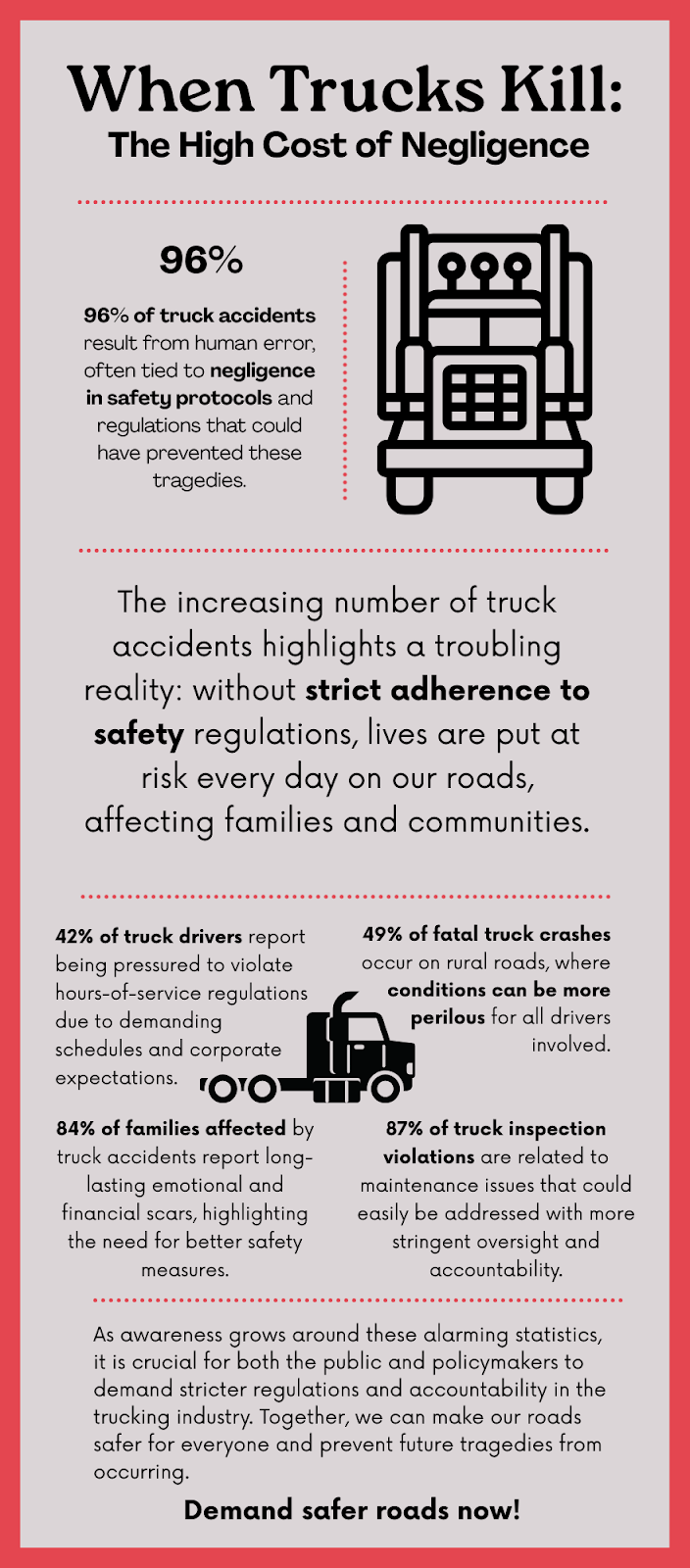According to 2023 data, 5,472 people died in crashes involving large trucks in the U.S. Another 86,842 people reported injuries from 170,716 truck-related accidents – that’s a staggering 420 a day. And a growing number of these incidents are due to negligence.
This study explores the growing toll of negligent practices in the American trucking industry, in particular, the number of wrongful death lawsuits and fatal truck crashes.
We’ll look into the different types of negligence that have led to so many road accidents, where and when the accidents happen, who the main culprits are in terms of lawsuits, and what changes need to be made to stifle a spiralling problem. With so many trucks now on U.S. roads, it’s an issue that requires an urgent solution.
Trucking Negligence: Company And Driver Violations
There are currently 13 million trucks registered in the U.S., 2.9 million of which are semi-trucks. 1.86 million companies operate a semi-truck, straight truck, or other type of hazardous-material carrying truck.
In 2024, the trucking industry pulled in $987 billion, up from $940.8 billion in 2022. U.S. freight companies are thriving, with their prominence set to grow over the coming years. Yet, with such rapid growth and success, there have been repercussions.
As the trucking industry has become increasingly prominent, with truck travel increasing 231% since 1970, the number of crashes involving large trucks has soared.
Between 2009 and 2023, the number of fatal crashes involving large trucks rose from 2,983 to 4,354; 65% of fatalities were occupants of other vehicles, while pedestrians and cyclists made up 17%. And it’s not purely a matter of busier roads due to more trucks that’s led to accidents – 32% of truck accidents are due to speeding, with an increasingly high number of accidents and fatal crashes due to negligent driver behavior.
Truck Driver Safety Violations
Hours of Service (HOS) Violations
In the U.S., to make sure trucks are roadworthy and that drivers are following the correct protocol, roadside vehicle violation checks are routinely performed.
These are carried out by law enforcement officers and commercial vehicle safety inspectors employed by state agencies or the Department of Transportation. In each case, the designated inspecting officers can stop any vehicle, inspect it, and issue a citation or prohibition if they find any violations of traffic laws and/or safety regulations.
In 2023, HOS violations made up over 40% of the driver-related violations identified during roadside inspections. In fact, during the 2023 International Roadcheck, HOS violations were the main reason U.S. drivers were placed out-of-service, with 845 out-of-service orders issued.
Also in 2023, 58,918 drivers were cited for HOS violations, which represented 5.37% of all violations categorized as CSA Violations (safety regulation violations committed by commercial motor carriers and their drivers). The most frequently reported HOS violation was driving beyond the 14-hour duty period, which accounted for almost half of all HOS violations.
ELD-related violations (non-compliance with regulations pertaining to the mandatory use of an electronic logging device), such as failing to maintain a record of duty status (RODS) or using an unauthorized device, made up roughly 10% of all HOS violations.
In 2024, log falsification (an HOS violation) was a huge issue, with one carrier facing a $87,830 fine. Log falsification has been the main HOS violation since ELDs were first brought into commercial trucks. Yet there are still many other notable truck violations keeping roadside inspectors busy.
Roadside Inspection Violations
Beyond HOS violations, here are some other reasons inspectors issue citations or prohibitions against a truck or its driver (2023 figures). (Note: CSA severity weight points, which range from 1 to 10, represent the relative risk of a crash, with 1 the lowest risk and 10 the most severe.
The attribution of CSA severity weight points determines which trucking companies will subsequently be targeted for enforcement action.
- Failure to obey a traffic control device – 65,448 violations, with each violation earning 5 CSA severity weight points.
- Speeding 6-10 miles per hour over the speed limit – 61,267 violations, with each violation earning 4 CSA severity weight points.
- Falsely reporting a driver’s record of duty status – 52,962 violations, with each violation earning 7 CSA severity weight points.
- Operating a commercial motor vehicle (CMV) without a commercial driving license (CDL) – 52,516 violations, with each violation earning 5 CSA severity weight points.
- Not using a seat belt while operating a CMV – 62,413 violations, with each violation earning 8 CSA severity weight points.
- Operating a property-carrying vehicle without a valid medical certificate – 42,379 violations, with each violation earning 1 CSA severity weight point.
- Lane restriction violation – 40,616 violations, with each violation earning 3 CSA severity weight points.
Over the current year so far (up to June 6, 2025), study data reveals that, from 11,665,091 driver inspections, there were 4,662,911 driver violations; perhaps worse still, there were 944,512 violations committed by out-of-service (OOS) drivers.
Far more seriously, there were also thousands of deaths due to truck accidents.

Where and When: The Key Danger Times and Places for Truck Crashes
In 2023, of 4,354 fatal truck crashes, 2,214 (51% percent) deaths occurred on major roads (other than interstates and freeways), 1,471 (34%) occurred on interstates and freeways, and 658 (15%) occurred on minor roads.
In terms of especially dangerous time periods, 47% of all truck fatalities occurred between 6 a.m. and 3 p.m. (To compare, just 28% of all other types of crashes took place during that period.)
Here’s a list of 2023 daily time periods, and the associated fatality numbers for both large trucks and other vehicle crashes (plus a combined total).
| Time | Large truck crashes | Other vehicle crashes | All crashes |
|---|---|---|---|
| Midnight – 3 a.m. | 375 (9%) | 4,338 (12%) | 4,713 (12%) |
| 3 a.m. – 6 a.m. | 519 (12%) | 3,225 (9%) | 3,744 (9%) |
| 6 a.m. – 9 a.m. | 613 (14%) | 3,113 (9%) | 3,726 (9%) |
| 9 a.m. – noon | 706 (16%) | 2,837 (8%) | 3,543 (9%) |
| Noon – 3 p.m. | 713 (16%) | 4,265 (12%) | 4,978 (12%) |
| 3 p.m. – 6 p.m. | 658 (15%) | 5,590 (15%) | 6,248 (15%) |
| 6 p.m. – 9 p.m. | 400 (9%) | 6,842 (19%) | 7,242 (18%) |
| 9 p.m. – midnight | 365 (8%) | 6,050 (17%) | 6,415 (16%) |
| Total | 4,354 | 36,547 | 40,901 |
Chief Culprits: the Trucking Companies Subject to the Most Lawsuits
Night or day, whenever a driver crashes a truck, they do so while representing a commercial freight company. According to Justia Dockets data, here are the trucking companies that faced the most personal injury lawsuits up to January 2025.
| Trucking Company | Number of Lawsuits |
|---|---|
| Swift Transportation | 299 lawsuits |
| Werner Enterprises | 289 lawsuits |
| Schneider National Carriers | 154 lawsuits |
| Western Express | 103 lawsuits |
| USA Truck | 95 lawsuits |
| Prime Inc. | 86 lawsuits |
| Stevens Transport | 67 lawsuits |
| Marten Transport | 64 lawsuits |
| Con-way Inc. | 61 lawsuits |
| Knight Transportation | 56 lawsuits |
Accidents by Freight Type
And there are many different types of crashes, involving different types of freight. For example, over the past decade, big rig accidents involving hazardous materials (hazmat) have surged by 155%.
Hazardous Materials
During that period, PHMSA data reveals that there have been 52 fatalities and 160 injuries due to hazmat incidents involving tractor-trailers in transit. Beyond the mortal devastation, hazmat spills can cause significant long-term environmental damage requiring costly, specialized cleanup procedures.
In 2023, trucks carried nearly 856 million tons of gasoline, 644 million tons of fuel oils, 460 million tons of natural gas and other fossil fuel products, and more than 19 million tons of crude petroleum over U.S. roads. The hazmat risk-factor is constant, which increases the need for due care and diligence when it comes to keeping a truck roadworthy and making sure the driver follows protocol.
For every hazmat train accident, there are 33 hazmat incidents involving heavy-load trucks, with 38.68% of hazmat-related crashes occurring on interstates. In over 75% of cases, driver error – largely due to fatigue and inattention – is to blame. And, worryingly, in over 90% of cases, a hazmat incident involving a driver is a repeat offense.
That said, load size can significantly increase the trucking danger factor: 63% of rollover crashes occur when a cargo tank is carrying only a partial load, partially due to faster possible speed, more mobility, and variable load imbalance.
If a hazmat crash happens, federally-mandated insurance minimums ($1 million per accident for big oil rigs; $5 million if hauling particularly hazardous material) serve as a hazmat liability cap.
Oversized Loads
Oversized loads are also regularly involved in severe accidents, such as the 2023 Texas crash involving a detached 350,000-pound load, which resulted in two fatalities.
Such loads often require special permits and escorts. A failure to observe tight regulations increases the risk of an accident due to subsequent maneuverability and braking difficulty.
Perishable Goods
Perishable goods necessitate timely delivery. Whenever trucking involves a race against the clock, there are often associated driver fatigue and speeding risks, both of which are common features in truck accidents.
Additionally, if perishable items are not properly secured, they can shift during transit, causing an imbalance and a loss of vehicle control.
Summary
In 2023, of 168,000 truck accidents in the U.S., 32% resulted in injuries, 3% in fatalities. So many of these needless deaths – a staggering 96%, according to study data – are due to avoidable human error.
Approximately 32% of truck-related accidents were linked to speeding, with HOS violations accounting for over 40% of all driver-related inspection failures, with driving beyond the 14-hour duty limit the most common infraction.
And in 87% of truck inspection violation cases, the maintenance issue in question was due to a lack of driver/company oversight and not enough due diligence around routine repairs.
These statistics are unacceptable, and with more regular, more mindful vehicle maintenance, so many subsequent accidents and fatalities could be avoided. HOS violations are largely due to putting profits over safety, with 42% of truck drivers admitting being put under pressure by their company to violate hours-of-service regulations.
Similarly, speeding is a matter of chasing targets and fulfilling delivery expectations, particularly regarding perishable goods. And because so many accidents are second and third offenses, the severity of the consequences for committing a trucking offense may need to be increased.
❝In over 75% of cases, driver error – largely due to fatigue and inattention – is to blame. And, worryingly, in over 90% of cases, a hazmat incident involving a driver is a repeat offense.❞
Ultimately, a failure by drivers and freight companies to adhere to safety regulations is the key issue. Until more punitive measures are introduced to encourage this, drivers and freight companies will continue to violate regulations, needlessly putting the lives of drivers, cyclists, and pedestrians in grave danger.
At Bader Law, our personal injury and workers’ compensation attorneys have the background, skill sets, and grit necessary to resolve even the toughest cases.
All of our lawyers are members of the State Bar of Georgia, the Georgia Trial Lawyers Association, and the Atlanta Bar Association. If you need help with a trucking negligence issue, get in touch with us today.












